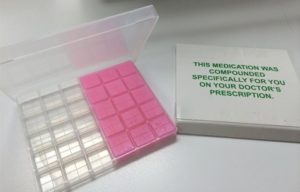Recommendations for Ketamine Clinicians During COVID
Version 1 – Posted on 3/20/20
In light of COVID, KRIYA Institute is advising all ketamine providers to immediately stop providing in-office services in order to slow or halt the spread of Coronavirus. Instead, move your existing ketamine patients to at-home ketamine treatment using compounded products (e.g., hard lozenges, rapid dissolve tablets, or nasal spray). Some suggestions for this transition are provided below. Note that this is meant to be a temporary strategy to respond to the current COVID crisis.
DIRECTIONS
(1) Have a written CONTRACT for each patient that contains the following essential information:
– When to take ketamine (is it on a schedule, or is it when specific symptoms appear?)
– How much ketamine to take (dose)
– When and how to contact you
(2) Have a LOG for patients to fill out to document their ketamine use. The log should contain the following essential information for every ketamine dose:
– Date
– Time
– Amount (dose)
– Notes (what did the patient notice?)
(3) Have an INSTRUCTION SHEET that contains some or all of the following information:
– Guidelines for fasting
– Guidelines for personal preparation (such as setting an intention)
– Guidelines for preparing the setting
– Possible adverse reactions, and what to do about them
– Guidelines for driving
(4) Order the medication. You can order ketamine products from any compounding pharmacy in your state. The compounding pharmacy will mail the product directly to the patient. The most frequently ordered compounded product is a hard troche (a/k/a lozenge), fruit flavor, 100 mg of racemic (generic) ketamine per troche. Start by ordering a small number of lozenges with no refills. After the patient proves to be responsible with this controlled substance, then you can refill their prescription. Let’s try to avoid another “opioid crisis” by not having loose prescribing practices.
(5) Consider recommending online psychotherapy for your patients. Many therapists have moved their practices online, and have added extra slots to help people cope with the stress of COVID.
(6) For new patients seeking ketamine treatment during COVID, continue to do thorough intakes, provide careful instructions, and be attentive to the therapeutic relationship with each patient.
CHALLENGES
(1) Transbuccal and nasal ketamine have poor bioavailability and variable mental effect. Transbuccal and nasal ketamine are typically estimated to be around 40% bioavailable, but the actual bioavailability ranges from 25-60%. These routes of administration are much less precise that IM/IV ketamine, which is a major drawback. Ask the compounding pharmacist for assistance, if needed, and warn your patients that the effect could feel different on different days.
(2) There is not one dose of ketamine that works well for everyone. As a clinician, there is always a tension between leaning low and leaning high in the dose. People are under a great deal of contextual stress at this time, so for that reason, it would be prudent to lean low with the dose, to avoid disorienting or frightening experience when the clinician is not present. (When the patient has a history of early, chronic, or relational trauma… those would also be good reasons to lean low with the dose at the beginning of ketamine treatment.) On the other hand, some patients may need a higher dose of ketamine during this period to help them manage their depression, anxiety, or suicidality. It is matter of clinical judgment which way to lean, and this decision should be made on a case-by-case basis for each individual patient.
(3) Be careful about having patients work in the psychedelic dose range at home. The psychedelic dose range is 1.0 – 2.0 mg/kg of bioavailable ketamine. Many people are feeling agitated and frightened by the COVID crisis. This is generally not a good mindset for beginning a psychedelic or mind-altering exploration.
(4) Ketamine clinicians should be attentive to and concerned about the following:
– Habituation / Tolerance
– Cystitis
– Accidents
– Addiction
– Diversion
Despite these challenges, treating ketamine patients at home appears to be best choice for now.
RATIONALE
Many institutions and ketamine providers have temporarily suspended IV ketamine treatment due to the COVID crisis. The rationale is that there are alternate routes of administration available for continuing ketamine treatment at home, so it does not qualify as an “essential” medical service. Suggesting that your patients come in for IM/IV ketamine treatment is irresponsible and unethical at the present time. Asking patients to come to your facility puts everyone at risk for further COVID spread: the patient, your staff, yourself, the driver, etc. There is no doubt that ketamine treatment saves lives. (No one appreciates that point more than me!) As clinicians, we absolutely need to continue to make ketamine available to patients who need it, but we may need to change the route or the dose temporarily.
Be wary of providers who claim that IV ketamine is the “gold standard” for ketamine treatment. This may be true for ketamine used in the OR or ER, but there is no clinical evidence whatsoever that any one route for therapeutic ketamine is superior to other routes. The efficacy of ketamine is a function of the dose, not the route. Each route has advantages and disadvantages.
FOR PRESCRIBERS IN CALIFORNIA
Our team orders compounded ketamine products from Koshland Pharmacy in San Francisco. We have found them to have high standards with respect to product quality and customer service. Dr. Peter Koshland has generously offered a professional courtesy discount to the KRIYA community.
